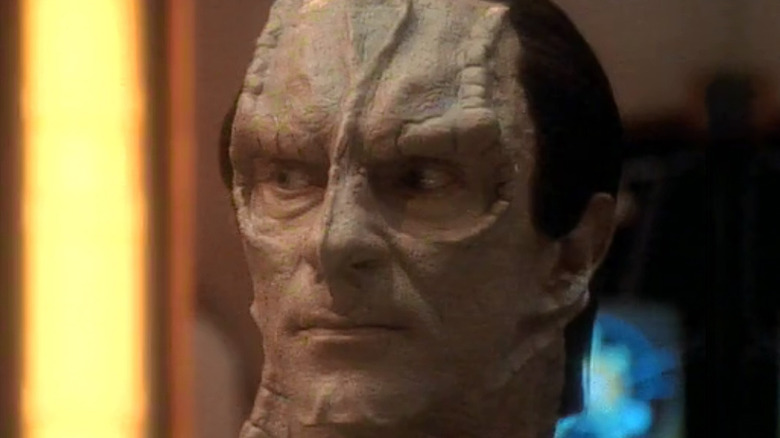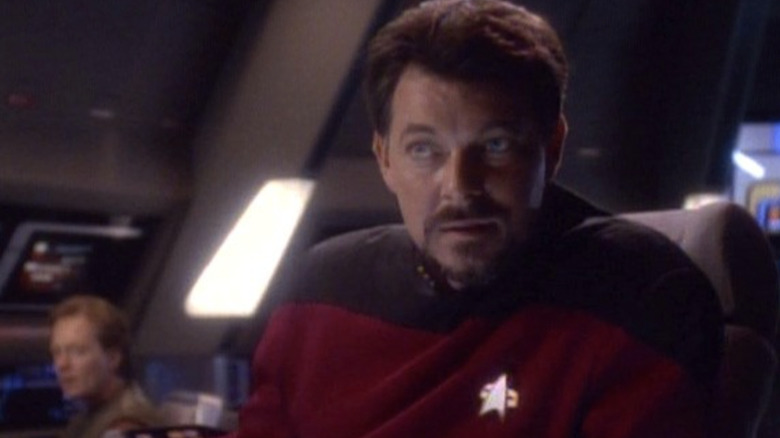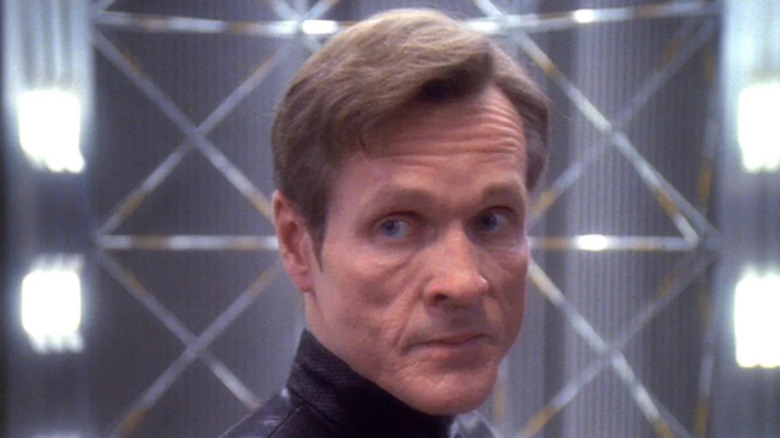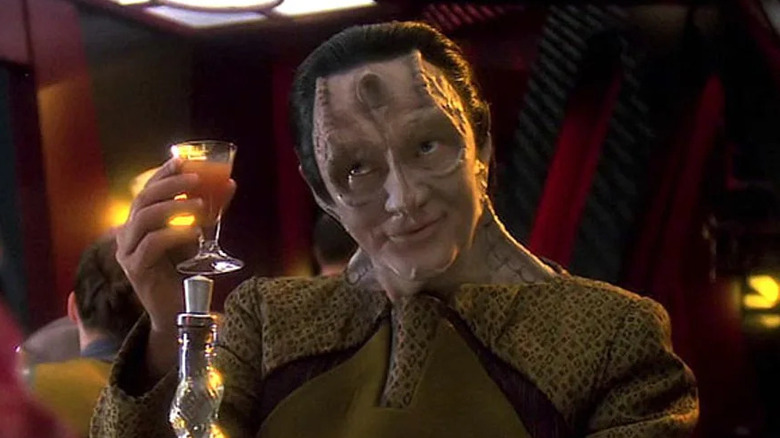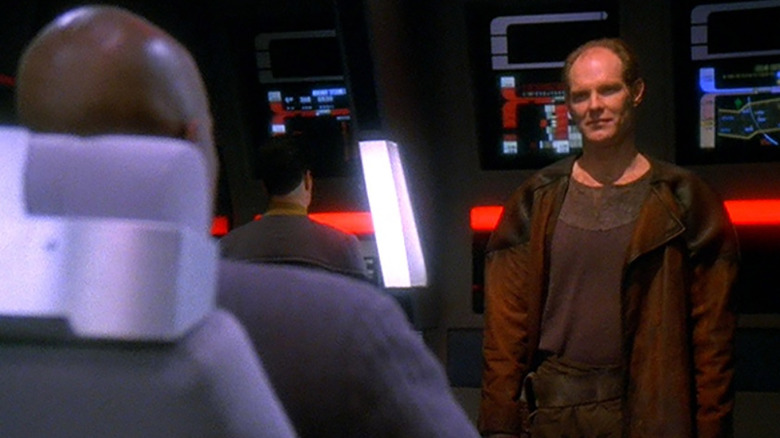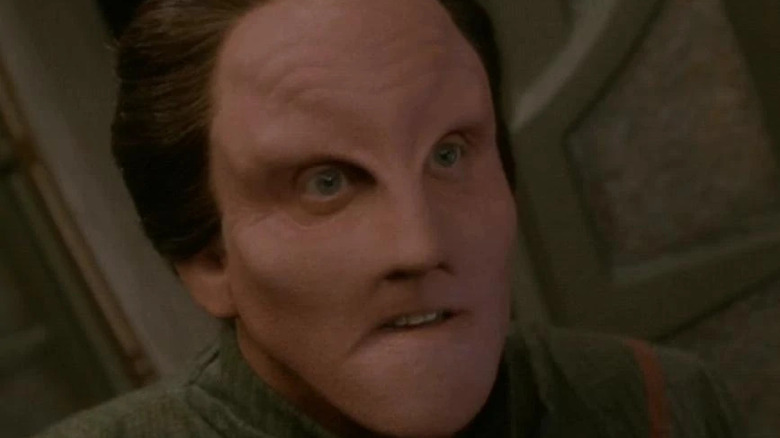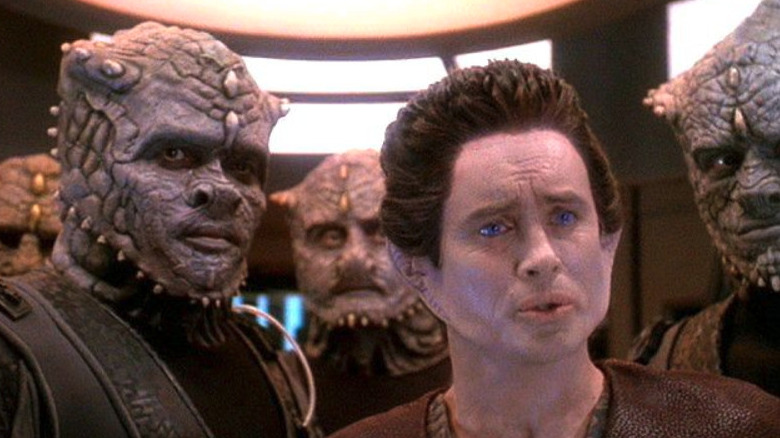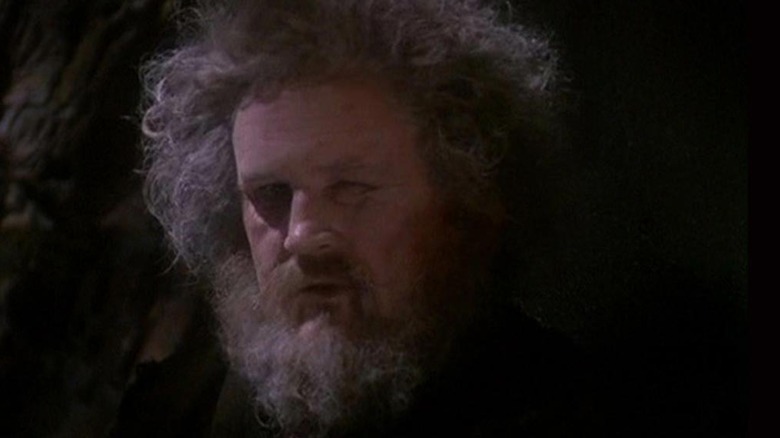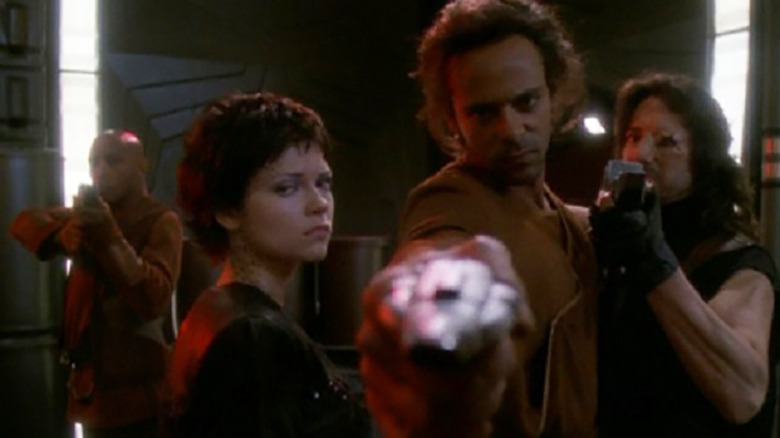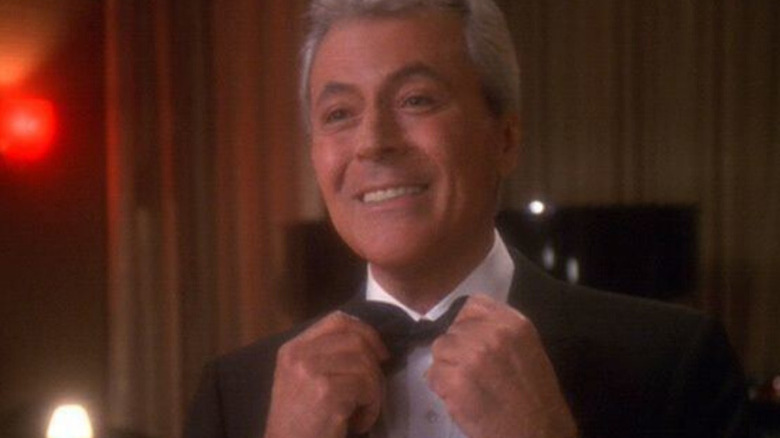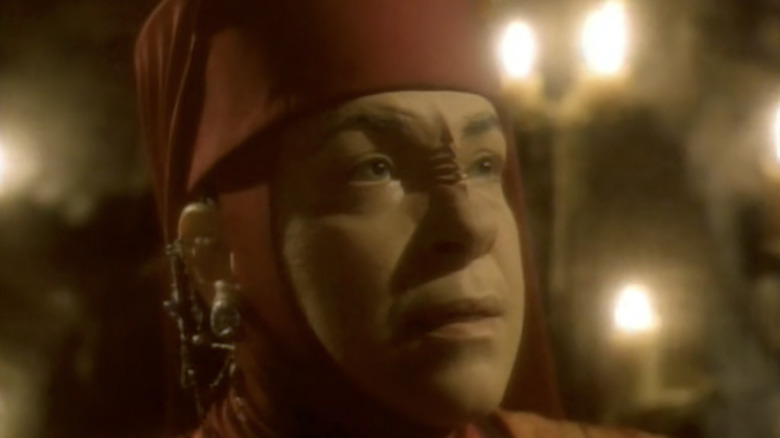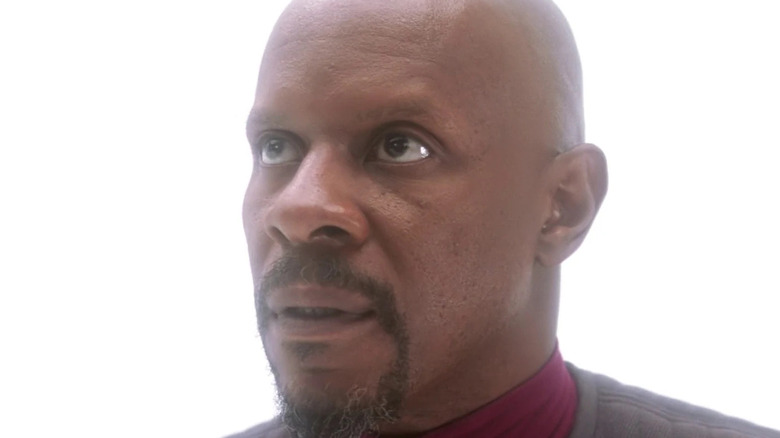Unresolved Plotlines From Star Trek: Deep Space Nine
After the first "Star Trek" revival — "The Next Generation" — hit airwaves in 1987 and was greeted with great applause, a spin-off was ordered just a few years later. This time set aboard a space station outside Federation space and at the mouth of a newly discovered wormhole leading to the distant Gamma Quadrant, "Star Trek: Deep Space Nine" became a sci-fi equivalent to "The Rifleman" – a backwater town where heroes, villains, and rogues would stop off to have adventures each week.
A darker, more mature "Star Trek" with a less black-and-white moral compass, "Deep Space Nine" was able to tell far more complex stories than its older brother "The Next Generation," especially once the studio's attention turned to the "TNG" movies and the eventual third spin-off "Star Trek: Voyager." Embracing serialized storytelling, the show was full of nuanced plotlines that carried over week to week, season to season, in an era where that was quite uncommon.
But "Deep Space Nine" eventually became so full of stories that the writers sometimes couldn't keep up, and several storylines and characters fell by the wayside before their journeys were complete. The final season did a good job of wrapping up a lot of the dangling plot threads and character arcs — including the Maquis, the Grand Nagus, Martok, and Sisko's war with the Pah-wraiths — but there were plenty left unresolved. Here's a list of the most egregious unfinished stories on "Star Trek: Deep Space Nine."
Rescuing Thomas Riker
The "Next Generation" episode "Second Chances" introduces us to a duplicate of Commander William Riker, created during an unusual transporter incident that leaves the double marooned on a desolate planet for eight years. On a mission by the Enterprise back to the same planet, the other Riker is discovered and eventually takes the name of Thomas Riker, resuming his Starfleet career from the point he left off as a young lieutenant. Later, in the "Deep Space Nine" episode "Defiant," Thomas Riker turns up posing as Will Riker to steal the station's experimental new starship, the U.S.S. Defiant. It is revealed that after returning to Starfleet life, Thomas Riker became a member of the terrorist organization known as the Maquis and stole the ship to expose a Cardassian plot in the demilitarized zone.
To stop him, Captain Sisko and Gul Dukat briefly join forces to hunt him down and stop him from destroying apparently innocent ships and jeopardizing peace with Cardassia. In the end, Thomas is apprehended, and in true Riker fashion, he negotiates to spare the lives of his crew in exchange for a life sentence in a Cardassian prison. Major Kira promises him they'll return to rescue him, but through the series' remaining four seasons, we never see that come to pass. Was he rescued by another Starfleet team? Was he killed when the Dominion turned on Cardassia? It's also possible that he was simply released after the Cardassians surrendered to the Federation. Whatever happened, if he did survive, it means there are still two Rikers running around in the world of "Star Trek: Picard."
The untold truth of Section 31
In the 5th season episode "Inquisition," we meet a mysterious figure called Sloan who claims to be with Starfleet Intelligence on a mission to ferret out a possible Dominion double agent. At the episode's close, however, he reveals himself as a high-ranking operative of a clandestine Starfleet organization called Section 31. He returned twice more, ultimately ending his own life to prevent his secrets from being exposed. Sloan claims in "Extreme Measures" that Section 31 has no headquarters, and while it could have been a lie to trick Doctor Bashir, other information revealed about the organization certainly left us with more questions than answers by the end of the series' run.
We see Section 31 again in the prequel series "Star Trek: Enterprise" set some 200 years earlier and in fellow prequel series "Star Trek: Discovery." And while it even popped up in the alternate timeline of J.J. Abrams' "Star Trek Into Darkness," we've yet to learn much about Section 31 in the 24th century, or how it evolved from a known arm of the government in "Discovery" into the shadow agency we see in "DS9." How does Section 31 operate? Who are its members? And perhaps more importantly, who is its leader? The story of Section 31 is one of the most intriguing subplots of the series and perhaps one of the most important developments in the "Star Trek" franchise of the era, yet we never really did learn much about it. With a "Section 31" series said to be in development, perhaps we'll get more answers soon.
What happened to Garak?
First appearing in the Season 1 episode "The Wire," Garak is an enigmatic Cardassian — the last on the station — who was supposedly exiled from his homeworld and left to eke out an existence as a mere tailor aboard Deep Space Nine. Over the course of the series, we get drips and drabs of Garak's shrouded past: He was a spy working with the Obsidian Order — the Cardassian secret police and espionage agency — and an enemy of Gul Dukat. Apparently the son of the Order's leader Enabran Tain, it's never quite revealed why Garak was banished, though several possible explanations are offered up, including a few conflicting stories by Garak himself. Whatever the real reason, Garak made enemies in all corners of the Cardassian government, and when Tain died, he had seemingly lost his last best hope of returning to his home.
But as "Deep Space Nine" comes to a close and the Cardassians betray their Dominion allies, Garak is sent back to Cardassia. There, he and Major Kira go on a secret mission to aid rebel leader Damar, who helps the people rise up and take back the planet from the Dominion. Damar dies in his revolution, are Garak himself leads the final push to overthrow the Dominion. With Cardassian now free, it's suggested that Garak could be its next great leader. But it's never made clear, and for such a major turn for one of the show's most polarizing rogues, a definitive resolution to Garak's story was sadly missing.
The holographic communicator
While every "Star Trek" series has introduced new advances in technology — from communicator combadges to holographic doctors — it's rare that the technological status quo is shaken up in the middle of a show's run. The "Deep Space Nine" episode "For the Uniform" tried it briefly, though, with holographic communicators added to the U.S.S. Defiant. Producers Ronald D. Moore and Ira Stephen Behr discussed the matter in "Deep Space Nine Companion," with Moore claiming he wanted to try something new, having long felt that the show's 2D viewscreens were outdated for a show set nearly a hundred years after the original "Star Trek." But after trying out the new concept, Behr felt it was difficult to convey on television on a limited budget, and so after two episodes of use, they returned to traditional communication methods, and the holo-communicators disappeared without explanation onscreen.
"Star Trek" tried again, retconning the use of holo-communicators in the prequel series "Star Trek: Discovery," but they too disappeared after a short time — because they felt out of place in the prequel era, or because they too were difficult to execute onscreen, we never know for certain. What happened to them in-universe, though? Did they prove just as difficult to use for the crew as they were to convincingly create for producers? A follow-up story explaining the issue may have helped.
The Hundred
The station's resident Changeling, Odo, begins the series as a character with an origin shrouded in the unknown. He doesn't know where he came from or if there are more of his people out there — all he knows is he was discovered in his gelatinous state floating in space by Bajoran scientists. And one scientist, Mora Pol, discovers that Odo is a sentient being and raises him to become the eventual constable aboard "Deep Space Nine." But in the 4th season premiere, "The Search," the Federation learns about the Changeling race who rule the Dominion called the Founders, and Odo finally finds his people.
The leader of the Founders would reveal Odo's origins too, and tell how — to gather information about the galaxy — their people sent a hundred such beings as Odo out into space. These beings lived amongst "the solids" and eventually returned to their homeworld to share all they had learned. The 7th season episode "Chimera" introduced us to Laas, another such Changeling, who tried to convince Odo to leave the station with him to seek their orphaned brethren and form their own metamorph society. But Odo declines, and we never learn what became of him, his quest, or the fate of the other 98 Changelings sent to learn about the galaxy.
The Dominion
When the war with the Dominion ends in the series finale, "What We Leave Behind," the Founders surrender and call off their Jem'Hadar troops from their assault on the Federation and its allies. But what became of the vast army of Dominion soldiers, the Vorta commanders, and the thousands of ships and facilities that were already in the Alpha Quadrant? Surely there would have been a fight over their assets, with the Federation, Klingon, Romulans, and other powers all vying for control of the powerful technology that was left behind.
Meanwhile, what happened to the Dominion on the other side of the wormhole? With Odo going back to return to the Founder's Great Link, it's suggested that their galactic empire may have collapsed there as well. If it did, it might have led to chaos in the Gamma Quadrant, too. And without the Founders in control of them, what became of the Jem'Hadar? Even O'Brien warned in the episode "Hippocratic Oath" that the Founders may be the only thing keeping the vicious Jem'Hadar armies from "marauding through the galaxy." While there may be comics or books that deal with the aftermath, the fall of The Dominion feels like too big a story to leave so open-ended and almost demands a follow-up, as its ramifications are far too broad to leave unresolved.
O'Brien's life in prison
One of the darkest episodes in the pantheon of dark episodes of "Star Trek: Deep Space Nine," the O'Brien-centered entry "Hard Time," sees the chief convicted of a crime on an alien world and forced to experience 20 years of memories in prison in a matter of minutes. Doctor Bashir can't erase the memories, and O'Brien returns to duty a changed man: angry, short-tempered, bitter, and haunted by more than just his imprisonment. He begins to hallucinate the image of an alien named Ee'char, who acts as his conscience, and over the course of the episode, we learn that the implanted memories include O'Brien murdering his best friend and virtual cell mate over a few scraps of food.
Most of "Hard Time" deals with the mental struggle that O'Brien goes through during his recovery from imprisonment and his fight to reclaim his former identity. It's a powerful episode with a lot of important things to say about mental health and PTSD. Unfortunately, despite the often serialized nature of "DS9," O'Brien goes right back to his old self by the following episode. Apparently suffering no lingering effects, what could have been a longer, ongoing subplot about his attempts to recover from his life-altering experience in prison is instead quickly forgotten. With "Star Trek: Picard" revisiting his time as a Borg and the long-lasting trauma it created, perhaps we may revisit O'Brien's struggle at some point in the future.
If you or someone you know is struggling with mental health, please contact the Crisis Text Line by texting HOME to 741741, call the National Alliance on Mental Illness helpline at 1-800-950-NAMI (6264), or visit the National Institute of Mental Health website.
The mirror universe war
Not seen since the original "Star Trek" series episode "Mirror, Mirror" in 1967, "Star Trek: Deep Space Nine" surprised audiences with a return to the famous alternate reality where a goateed Mr. Spock was enslaved aboard the U.S.S. Enterprise. The so-called "mirror universe" appears in five episodes of "DS9," beginning with the Season 2 effort "Crossover," and amounts to a major story arc that sees an alliance of Cardassians, Bajorans, and Klingons subjugating mankind and other races in a brutal and oppressive regime. Over the course of the ongoing story, we learn that after Spock's visit from our Captain Kirk, he helped overthrow the Terran Empire, ultimately leading to the human race becoming the victims of a vast galactic power shift.
In several "Deep Space Nine" episodes, we meet a resistance made up of vulnerable races — including humans, Vulcans, and Ferengi — who seek out the help of the crew of Deep Space Nine in our universe to turn the tide over the Alliance. They use Sisko to convince a duplicate of his ex-wife to aid the rebels; build a duplicate of Sisko's powerful U.S.S. Defiant; and make a deal with Quark and Rom to secure a Klingon cloaking device in "The Emperor's New Cloak." It's suggested that the rebels could be on the verge of finally defeating the Alliance, but when we last see them, the fate of the mirror universe war is left unsettled. Perhaps we'll get an update in "Star Trek: Discovery" now that it's moved to the 32nd century, where Kovich seems aware of alternate universe goings-on.
What is Vic Fontaine?
The holographic lounge singer named Vic Fontaine first shows up in "His Way," an episode that sees Major Kira and Constable Odo finally getting together after years of the classic television "will-they-won't-they" trope. In the story, he's introduced as something more than a holodeck character, but something not quite as sentient as The Doctor over on sister series "Star Trek: Voyager." He becomes the conscience of the show for the last season and a half, and it's made clear by Bashir that Fontaine is a "unique" program. And if Voyager's Doctor gained sentience through his long hours online — something heavily suggested in several episodes — it's possible that Fontaine gained personhood in the same way after being left on round-the-clock in "It's Only a Paper Moon."
If Fontaine is indeed more like a real person than other pre-programmed holographic characters, it's also possible that after the arrival of the starship Voyager to the Alpha Quadrant at the end of their series, he could have been fitted with his own mobile emitter and allowed to walk free of his holosuite confines. But we're never quite told whether Fontaine is a sentient program or just an elaborate one. Of course, this one's a double dangling plot, as Vic Fontaine also made a brief cameo in the mirror universe episode "The Emperor's New Cloak." Here, his alternate reality counterpart at least appears to be a real person before he is unceremoniously killed in another mystery that the show never solves.
Kai Opaka's life on Bajor
Kai Opaka was the first — and highest-ranking — religious leader on Bajor shown on "Deep Space Nine." A wise, humble leader, she oversees the Bajoran faith on her homeworld and is highly revered and widely respected by her people. In the Season 2 episode "Battle Lines," she takes a trip to the Gamma Quadrant with Sisko and Major Kira, where they crash land on a desolate moon where two warring tribes are engaged in an endless battle. It's a war nobody can win because on this planet, nobody can ever die. Seriously injured in the crash, her presence on the moon saves her life, but Opaka refuses to leave with Sisko and Kira — she believes her place is there on the moon, helping bring peace to the two factions.
Unfortunately, we never see Opaka again or find out if she ever succeeded in uniting the two tribes. While her replacement, Kai Winn, was perverting the Bajoran faith and sabotaging their government, the writers had the perfect impetus to find Opaka a way off the magical moon so the two Kai's could have a final showdown. Not having her return while Bajor faced its greatest threat from the Pah-wraiths in the series' final episodes felt like a missed opportunity, too, as this could have wrapped up her story nicely.
A non-canon novel, "Rising Son," updates us on her whereabouts, showing her return to Bajor, but nothing was ever shown onscreen.
Sisko's prophecy
No Trek fan can possibly be satisfied with the fate of Benjamin Sisko at the conclusion of "What We Left Behind," the final episode of "Star Trek: Deep Space Nine." In some ways, it was the perfect conclusion for the character's seven-year-long journey from Starfleet commander to Emissary of the Prophets, as he sacrifices himself to end the threat of the Pah-wraiths. But after the captain becomes a non-corporeal entity residing in the Celestial Temple, the writers throw in one tantalizing line at the end of his final moments, teasing audiences of his possible return.
Before beginning his life as a Prophet, Sisko speaks to his wife Cassidy one final time from inside the Celestial Temple and tells her he has much to do. There are things he must learn that only the Prophets can teach him, he tells her, but before he vanishes, he promises her that he will return. When she asks when that might be, he's vague, saying only, "It's hard to say. Maybe a year. Maybe yesterday. But I will be back." It's a pretty declarative statement and must have made fans wonder if there were plans afoot for the series to make the move to feature films, or perhaps a TV mini-series follow-up somewhere down the line. Given actor Avery Brooks' disappearance from acting, however, any thought of revisiting Sisko's story seemed unlikely until recently, when rumors began circulating that he might be interested in reprising the role.
